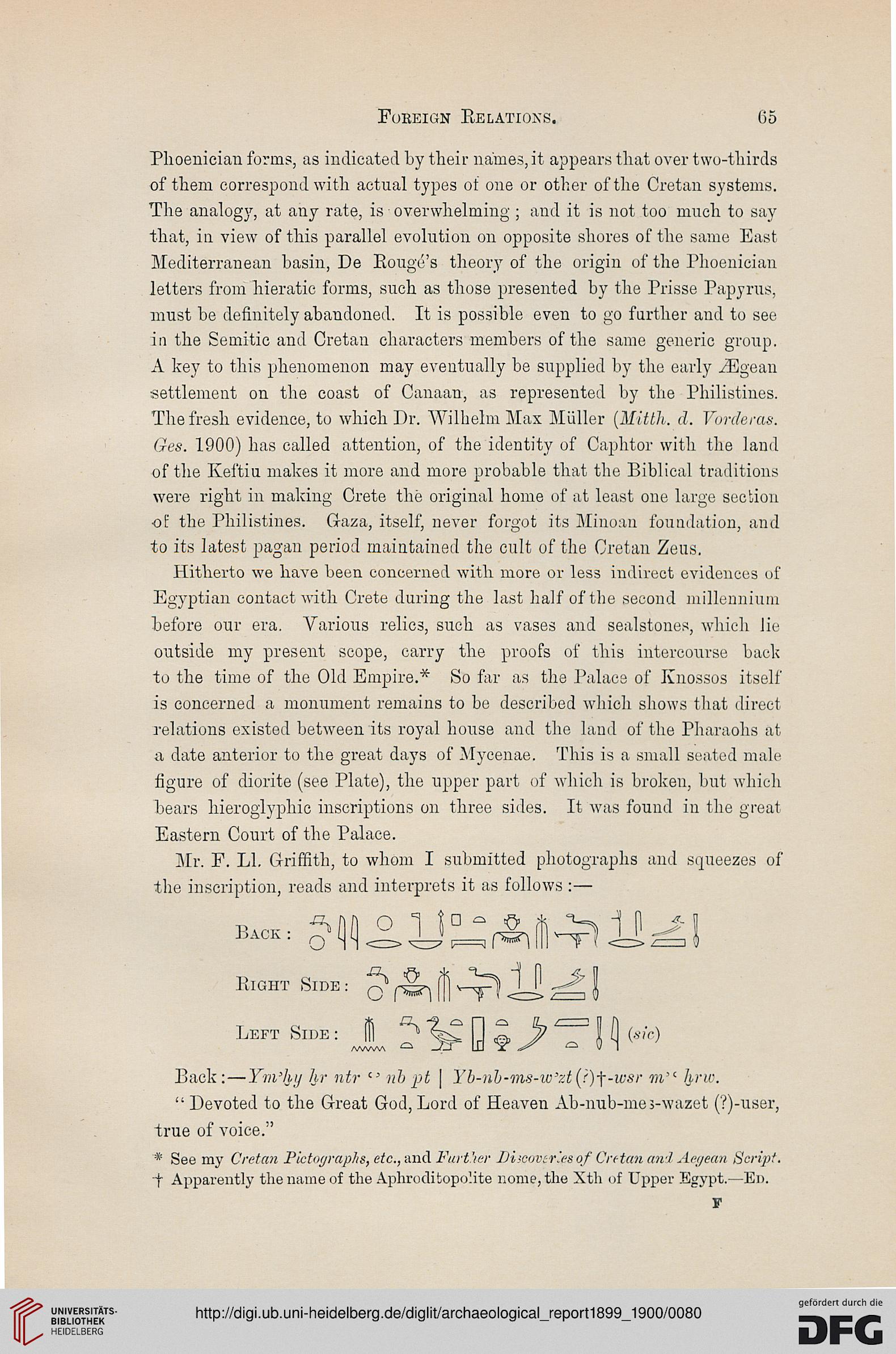Foreign Eelatioxs.
65
Phoenician forms, as indicated by their names, it appears that over two-thirds
of them correspond with actual types of one or other of the Cretan systems.
The analogy, at any rate, is overwhelming ; and it is not too much to say
that, in view of this parallel evolution on opposite shores of the same East
Mediterranean basin, De Eouge's theory of the origin of the Phoenician
letters from hieratic forms, such as those presented by the Prisse Papyrus,
must be definitely abandoned. It is possible even to go further and to see
in the Semitic and Cretan characters members of the same generic group.
A key to this phenomenon may eventually be supplied by the early iEgean
settlement on the coast of Canaan, as represented by the Philistines.
The fresh evidence, to which Dr. Wilhelm Max Miiller [Mitth. d. Vorderaa.
Ges. 1900) has called attention, of the identity of Caphtor with the land
of the Keftiu makes it more and more probable that the Biblical traditions
were right in making Crete the original home of at least one large section
of the Philistines. Gaza, itself, never forgot its Minoan foundation, and
to its latest pagan period maintained the cult of the Cretan Zeus.
Hitherto we have been concerned with more or less indirect evidences of
Egyptian contact with Crete during the last half of the second millennium
before our era. Various relic3, such as vases and sealstones, which lie
outside my present scope, carry the proofs of this intercourse back
to the time of the Old Empire.* So far as the Palace of Knossos itself
is concerned a monument remains to be described which shows that direct
relations existed between its royal house and the land of the Pharaohs at
a date anterior to the great days of Mycenae. This is a small seated male
figure of diorite (see Plate), the upper part of which is broken, but which
bears hieroglyphic inscriptions on three sides. It was found in the great
Eastern Court of the Palace.
Mr. F. LI. Griffith, to whom I submitted photographs and squeezes of
the inscription, reads and interprets it as follows :—
Back: — Ym'hij Jj.r ntr ° nb pt | Yb-nb-ms-w'zt (r)f-wsr m" lj,rw.
" Devoted to the Great God, Lord of Heaven Ab-nub-mes-wazet (?)-user,
true of voice."
* See my Cretan Pictographs, etc., and Farther Diicovtr'.es of Cretan awl Aegean Scrip'.,
■f Apparently the name of the Aphrodibopolite i:ome,the Xth of Upper Egypt.—En.
Back
Left Side : If]
v
65
Phoenician forms, as indicated by their names, it appears that over two-thirds
of them correspond with actual types of one or other of the Cretan systems.
The analogy, at any rate, is overwhelming ; and it is not too much to say
that, in view of this parallel evolution on opposite shores of the same East
Mediterranean basin, De Eouge's theory of the origin of the Phoenician
letters from hieratic forms, such as those presented by the Prisse Papyrus,
must be definitely abandoned. It is possible even to go further and to see
in the Semitic and Cretan characters members of the same generic group.
A key to this phenomenon may eventually be supplied by the early iEgean
settlement on the coast of Canaan, as represented by the Philistines.
The fresh evidence, to which Dr. Wilhelm Max Miiller [Mitth. d. Vorderaa.
Ges. 1900) has called attention, of the identity of Caphtor with the land
of the Keftiu makes it more and more probable that the Biblical traditions
were right in making Crete the original home of at least one large section
of the Philistines. Gaza, itself, never forgot its Minoan foundation, and
to its latest pagan period maintained the cult of the Cretan Zeus.
Hitherto we have been concerned with more or less indirect evidences of
Egyptian contact with Crete during the last half of the second millennium
before our era. Various relic3, such as vases and sealstones, which lie
outside my present scope, carry the proofs of this intercourse back
to the time of the Old Empire.* So far as the Palace of Knossos itself
is concerned a monument remains to be described which shows that direct
relations existed between its royal house and the land of the Pharaohs at
a date anterior to the great days of Mycenae. This is a small seated male
figure of diorite (see Plate), the upper part of which is broken, but which
bears hieroglyphic inscriptions on three sides. It was found in the great
Eastern Court of the Palace.
Mr. F. LI. Griffith, to whom I submitted photographs and squeezes of
the inscription, reads and interprets it as follows :—
Back: — Ym'hij Jj.r ntr ° nb pt | Yb-nb-ms-w'zt (r)f-wsr m" lj,rw.
" Devoted to the Great God, Lord of Heaven Ab-nub-mes-wazet (?)-user,
true of voice."
* See my Cretan Pictographs, etc., and Farther Diicovtr'.es of Cretan awl Aegean Scrip'.,
■f Apparently the name of the Aphrodibopolite i:ome,the Xth of Upper Egypt.—En.
Back
Left Side : If]
v





